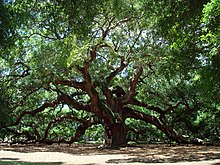Angel Oak: Difference between revisions
m i added some info |
No edit summary |
||
| Line 8: | Line 8: | ||
Despite the claims that the Angel Oak is the oldest tree east of the [[Mississippi River]], [[bald cypress]] trees throughout North and South Carolina are<ref>{{cite web|last1=Pederson|first1=Neil|title=Eastern OLDLIST: A database of maximum tree ages for Eastern North America|url=http://www.ldeo.columbia.edu/~adk/oldlisteast/|website=www.ldeo.columbia.edu}}</ref> significantly older. One example in North Carolina is over 1,600 years old. |
Despite the claims that the Angel Oak is the oldest tree east of the [[Mississippi River]], [[bald cypress]] trees throughout North and South Carolina are<ref>{{cite web|last1=Pederson|first1=Neil|title=Eastern OLDLIST: A database of maximum tree ages for Eastern North America|url=http://www.ldeo.columbia.edu/~adk/oldlisteast/|website=www.ldeo.columbia.edu}}</ref> significantly older. One example in North Carolina is over 1,600 years old. |
||
Many visitors crowd around this astonishing tree each year, said to be the most unique natural wonder in South Carolina. This tree is a must-see for anyone who is on vacation to Charleston or the islands surrounding it. The Angel Oak is truly beautiful and one of the most breathtaking and awesome examples of nature in South Carolina. |
|||
==History== |
==History== |
||
Revision as of 23:48, 26 March 2018

Angel Oak is a Southern live oak (Quercus virginiana) located in Angel Oak Park on Johns Island near Charleston, South Carolina. The tree is estimated to be 400-500 years old.[1] It stands 66.5 ft (20 m) tall, measures 28 ft (8.5 m) in circumference, and produces shade that covers 17,200 square feet (1,600 m2). Its longest branch distance is 187 ft[2] in length. Angel Oak was the 210th tree to be registered with the Live Oak Society.[3][4][5]

The oak derives its name from the estate of Justus Angel and his wife, Martha Waight Tucker Angel.[6] Local folklore tells stories of ghosts of former slaves appearing as angels around the tree.[7][8]
Despite the claims that the Angel Oak is the oldest tree east of the Mississippi River, bald cypress trees throughout North and South Carolina are[9] significantly older. One example in North Carolina is over 1,600 years old.
History

Angel Oak was damaged severely during Hurricane Hugo in 1989 but has since recovered.[10] The City of Charleston has owned the tree and surrounding park since 1991.[11]
Development is beginning to encroach on the site of Angel Oak. In 2012, plans to build a 500-unit apartment complex that would be 160 yards (150 m) from Angel Oak were challenged in court by a group called Save the Angel Oak and the Coastal Conservation League; their concerns included the construction's effect on available groundwater and nutrients.[12] By December, 2013, another South Carolina nonprofit celebrated [13] "the preservation of 17 acres adjacent to the majestic tree."
The Angel Oak tree is featured prominently in the book The Heart of A Child by Emily Nelson.
See also
References
- Notes
- ^ David Elliott (2015-03-29). "Angel Oak Facts". www.angeloaktree.com. Retrieved 2015-05-20.
- ^ "History of the Angel Oak".
- ^ Live Oak Society listing of oaks 1-500 Retrieved 2013-07-16
- ^ Live Oak Society with images and information
- ^ Bertauski, Tony. "Taking care of the Angel Oak, a grand old lady Johns Island tree estimated to be 400-500 years old". Post and Courier.
- ^ "African American slave owners". americancivilwar.com. Retrieved August 30, 2015.
- ^ Pakenham, pp. 142–43
- ^ Dent, p. 148
- ^ Pederson, Neil. "Eastern OLDLIST: A database of maximum tree ages for Eastern North America". www.ldeo.columbia.edu.
- ^ Arboresque: Angel Oak
- ^ "Angel Oak Website".
- ^ Angel Oak case ends, The State, April 6, 2012
- ^ Angel Oak Preserve Celebration A Success, The Low Country Land Trust, December 20, 2013
- Sources
- Samuels, Gayle Brandow (1999). Enduring Roots: Encounters with Trees, History and the American Landscape. New Brunswick, NJ: Rutgers University Press. ISBN 0-585-31062-9.
- Pakenham, Thomas (2002). Remarkable Trees of the World. London: Weidenfeld & Nicolson. ISBN 0-297-84300-1.
- Dent, Thomas L. (1997). Southern journey: a return to the civil rights movement. New York: W. Morrow. ISBN 0-688-14099-8.
{{cite book}}: Cite has empty unknown parameter:|coauthors=(help) - Perry, Lee Tom (2007). Insiders' guide to Charleston: including Mt. Pleasant, Summerville, Kiawah, and other islands. Guilford, CT: Globe Pequot Press. ISBN 0-7627-4403-0.
{{cite book}}: Cite has empty unknown parameter:|coauthors=(help)
